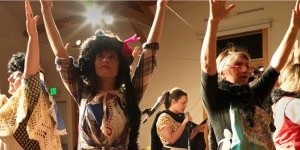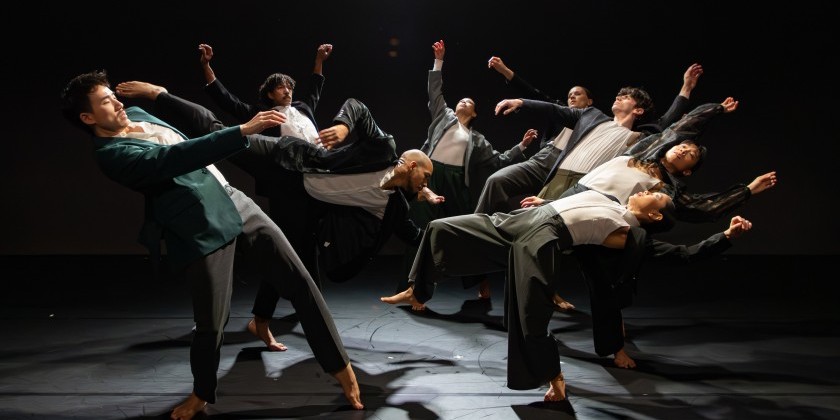IMPRESSIONS: Spring in Brief | Tushrik Fredericks, Coco Karol & Sxip Shirey, and Martita Abril

Performance at Triskelion, National Sawdust, and The Chocolate Factory Theater
As a live, embodied art form, performance rarely takes place in isolation. Creators, performers, collaborators, and technical support professionals work together to craft and present work in its fullest state, and the dialogic exchange with the audience is vital to the work’s completion.
This reliance on communal thought, labor, and witnessing extends into the themes artists explore in their work: creating and holding supportive microcosms for ritual revelation, transcending difference through shared tellings of intimate testimonials, and exploring cultural textures and frictions to craft understanding and shared joy. Three works this spring touch on these methods to create worlds from deeply-rooted questions, experiences, and imaginations.
Tushrik Fredericks' til infiniti at Triskelion Arts
Choreography & Conceptual design: Tushrik Fredericks
Solos in collaboration with dancers
Dancers: Claude Johnson, Channce Williams, Nouhoum Koita & Tushrik Fredericks
Sound designer: TT BRITT // Clothing: Dauan Jacari // Lighting: Connor Sale
Thought partner: Ashley Pierre-Louis // Set design support: Anna Watering & Lucca del Carlo
Date: May 29, 2025

A stagescape of crumpled and suspended mylar sheets creates an environment for reflection as four dancers reveal themseles through meditation, vulnerability, and catharsis. Thick slowness and tender encounters with gravity build into undulating phrases that pass through the group like an imperative. The ritual of support continues as each individual breaks away in solo expressions: slithering under amber light, carving the space around them, and pounding restlessly from inside. Tension mounts in rhythm and breath, channeling through body and voice as sharp intakes of breath and forceful exhalations rise and mix with guttural laughter and primal screams. In the dark wake of this catharsis, each performer offers themselves in turn, exhausted and cleansed by the experience: they test their limits, stretching further and probing deeper into every gesture and movement. Seated on the risers beside us, they watch each other with a focused care that radiates into our own gazes. Motifs of trust reemerge as they reconvene to cluster in falls and catches and lift each other, spine against spine, carrying their weight together.

Under flickering light, they return to the rhythms of sweat-drenched unison and join forces to burst through a wall of boxes at the back of the space. As sound throbs around them, they spin in open-armed surrender, at once emptied and filled by their shared ritual. til infiniti conjures questions and dreams to posit ways of being together and strengthening bonds through individual and collective embodied experience.
Coco Karol & Sxip Shirey's We Don’t Need the Sea to Drown at National Sawdust
Creators: Coco Karol and Sxip Shirey
Archival Filmaker an&d Documentarian: Jacob McCoy
Performers: Sxip Shirey, Coco Karol, Jonny Rodgers, Rima Fand, Nick Demeris, Alaina Ferris, Catherine Brookman, Miguel Guzmán, Jalen Hicks, Raquel Klein, Nathan Repasz, Onome, and Lacy Rose
Date: June 7, 2025
Community-engaged storytelling lies at the core of the creative partnership between dancer and choreographer Coco Karol and composer and sound artist Sxip Shirey, who arrange movement, sound, and words into embodied ethnographies derived from movement interviews that channel participants’ stories and emotions through their bodies. The performers — dancers Karol and Miguel Guzmán weave among Shirey and an ensemble of ten vocalists and musicians — act as channels for the stories of nineteen interviewees, passing words and gestures from body to body and voice to voice.
Across themes of ecological memory, migration, displacement, and grief, the artists activate chains of empathy and solidarity with an urgency that touches the soul in ways that the constant flow of news and social media are incapable of approaching. Each artist’s distinct voice rings clear and true as lyrics cascade through the chorus in rolling waves of accumulative harmonies imbued with a profound sense of recognition. Performers move about the space with the deep intimacy of trust: they slip small stools underneath a partner’s feet to guide their winding steps, Karol and Guzmán entwine through a duet of quiet desperation with eyes closed, and each vocalist offers private encounters with the quietest of music against each of our ears.
Shirey’s composition makes use of traditional instruments such as piano, violin, and percussion as well as a variety of everyday objects that create unexpected music: wavering, ethereal harmonies from an array of tuned water glasses, pinging polyrhythms from irrigation bags that drip water onto overturned metal bowls, and assorted textures from marbles spun in glass bowls, a broom’s bristles crunched by hand in time with footfalls, and the single virtuosic twirl of a cast iron weight plate. Karol’s tactile, organic choreography spools tension through intense internal focus and threads of interdependence; the care and intention offered in her winding duets with Guzmán run through gestures and interactions among chorus and musicians.
The transient beauty of life and the unknowable nature of death remain ever-present in songs and dances that flood and meander through the space, enveloping us in their sonic bubble and coalescing into formations of collective power. By amplifying individual stories through their art, Karol, Shirey, and their ensemble craft a moving tribute that continues to resound in my mind and heart.
Martita Abril's Tacos de Lengua at The Chocolate Factory Theater
Creators & Performers: Martita Abril in collaboration with Martha Abril Quiñones, Dylan Ellis, lily gold, Quique Rios-Ellis, Tia Raquel Quiñonez (La Tolingo), Tuçe Yasak, Josh Ray, and Directos de la Sierra
Date: June 14, 2025
Martita Abril's Tacos de Lengua. Photo: Brian Rogers
The trend toward “immersive” performance intends to shake up traditional spectatorial orientations, though more often than not falls short of transforming this relationship into something new. Martita Abril’s multidimensional community offering pushes against the prevailing notion of “immersive” performance by making itself thoroughly at home in The Chocolate Factory’s unique warehouse environs. Half the space functions primarily as a stage, filled with symbols and quiet rituals, while the other half is revealed midway as a vibrant fiesta, complete with taco stand, mezcal tasting, and a live banda ensemble, Directos de la Sierra.
These two halves strike contrasts and consonances that bring into relief the textures and sensations of Mexican border culture. In the stage space, a high, red altar wall bears dozens of twinkling candles among winding tree branches, backlit swaths of bright papel picado cast dappled shadows on the walls, and a muted environment of street sounds, wind, barking dogs, and songs played as if through a distant radio accompany Abril’s slow, steady progress through the space. She pushes a small cart; spine deeply curved, her hair falling over her downturned face, evoking the exhaustion — but never resignation — of hard labor; her mother and aunt curve their bodies around hers, feet falling quietly in step. Mamá breaks away to sing us a song, accompanying herself on accordion, and ushers us into the waiting fiesta.
Abril and her kin hone our intensity of focus, rewarding us several times over with the sounds and smells of their home. Under brightly colored lights we eat, drink, and dance to the band’s infectious music; their songs speak of pain, longing, and joy with unflagging rhythmic drive and expressive power. Brief interludes craft intimacy — Mamá narrates a wall of portraits of artists and ancestors — and build tension, as Abril blasts through trance-like aerobics and ducks behind a screen of junk to swing an axe at a chunk of hardwood. She sweats at her task as the axe head plunges into the wood and rings against the concrete floor, yet still she holds music in her restless body. Her battle cry: “¡Que siga la fiesta!” And the party does indeed continue on: not in spite of, but because of the undercurrents of pain, longing, and labor that make the joys all the more precious and worthy of sharing.
Amid a pervasive political climate of uncertainty and division, each of these artists in their own way elevates the pressing need for community-based knowledge, communication, and celebration to reverberate through pathways of embodied empathy. Choreographies of bodies, sound, language, and sensory experience move performance from a relationship of spectatorial presentation to a space of transformation that aims to extend beyond the stage and into each of our worlds. In the face of grief, fear, oppression, aggression, and erasure, we — artists and audiences alike — must resist and persist with our greatest strength: the interdependence that fuels our indomitable creative spirits.











